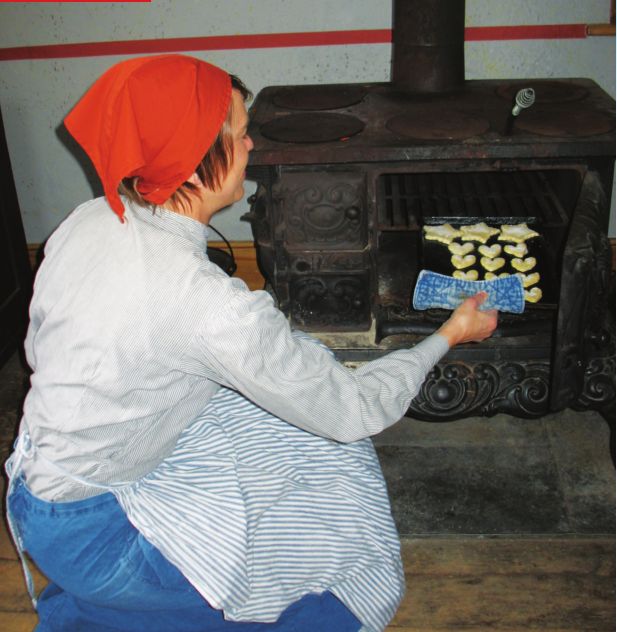
When Swedish seekers of religious freedom spent their first winter huddled in shelters dug into a ravine in what is now Bishop Hill, few probably guessed that, 169 years later, their settlement would host heart-warming winter holiday celebrations.
Followers of Erik Jansson were too busy trying to carve a utopia out of the harsh prairie after journeying from Sweden and walking 160 miles from Chicago. Despite poor shelter, a lack of food and the deaths of 96 out of 400 colonists the first year, the group built economic success with thriving farming and manufacturing. Unfortunately, Jansson’s murder by an unhappy colleague and subsequent financial mismanagement signaled the community’s demise 15 years later.
Today visitors to Bishop Hill can skip all that hardship and enjoy the work of Swedish descendants and historic preservationists in restoring many of the buildings, crafts and celebrations of the colony, including the upcoming Julmarknad (Christmas Market) and Lucia Nights.
Head 132 miles northwest of Springfield to sample Swedish traditions, decorations, folk characters, children’s activities, food, music and gifts at the Julmarknad from 10 a.m. to 5 p.m. Nov. 27-29 and Dec. 5-6. The first weekend features a cookie walk and the second a chocolate walk.
Watch for lighted candles and luminaries throughout the village during Lucia Nights from 6-9 p.m. Dec. 11-12, with open shops, museums and restaurants.
“Every window in every building has a single lighted candle,” said Todd DeDecker, administrator for the Bishop Hill Heritage Association. “It’s a Bishop Hill tradition, and Saint Lucia is known as the queen of lights.”
Village residents get into the spirit with young women dressed as Saint Lucia with candle wreaths on their heads for the special nights and children portraying mischievous Swedish elves or “tomten” during the market weekends, DeDecker said. “In Sweden, elves are to bring luck to your household if you give them porridge.”
Youngsters also will enjoy a man dressed as Julbock, the Christmas goat, based on a Scandinavian legend.
DeDecker said the market weekends appeal more to families and the Lucia
Nights to adults, but both celebrations draw thousands to Bishop Hill.
DeDecker
said the holiday happenings are some of the largest events at the
National Landmark Village, but visitors at other times also can soak in
Swedish heritage.
Bishop
Hill is an Illinois State Historic Site, and the state maintains three
buildings: the Bishop Hill Museum, Colony Church and Colony Hotel. Hours
for November through February are 9 a.m. to 4 p.m. (an hour later the
rest of the year) Wednesday through Sunday, but the buildings will be
open for Lucia Nights from 6 to 9 p.m.
The
museum makes a good first stop for an orientation DVD and a collection
of Olaf Krans folk art paintings of colony life. His primitive-style
portraits of stern settlers and industrious work scenes capture life as
Krans remembered it from his youth in the 1850s.
You
can tour some of the places Krans painted, including the Colony Church
and Colony Hotel. The church was the first permanent building at Bishop
Hill, a tribute to the importance of the settlers’ faith. The sanctuary
on the second floor speaks to that faith’s simplicity of worship and
Biblical basis with the pulpit as the centerpiece. A divider separated
men and women in their black walnut pews.
The
church basement and first floor served as early living quarters, and
visitors can peek into the 10 rooms, each heated with its own fireplace.
Residents ate in a communal dining room.
The
hotel housed Bishop Hill visitors, including business people, new
arrivals, lawyers and journalists attracted to the community’s early
economic success, and hosted dances and parties in the third-floor
ballroom. After the colony’s demise, the hotel continued to operate
until the 1920s, when it became an apartment building. The state took
over in 1968 and made it look like the original.
The
Colony Store is a popular stop for all things Swedish, including food,
decorations and gifts. Built in 1853, the store is owned by the Bishop
Hill Heritage Association with profits earmarked for restoration.
The
heritage group, the Bishop Hill Old Settlers’ Association and private
owners maintain many buildings in the rest of the community, including a
blacksmith shop, hospital, school, dairy building, administration
building, boys’ dormitory and carpenter and paint shop. Visitors can
walk several blocks to view the outside of these buildings, the
interiors of some and the sites of now-gone structures.
At
the cemetery, you can visit the graves of settlers, including Eric
Jannson’s monument, a tribute to the man who helped his followers to
forge a new life in Bishop Hill and their descendants to share their
holiday traditions with all of us.
For more information about Bishop Hill, go to www.illinois.gov/ihpa/Experience/Sites/ NorthWest (click on the Bishop Hill link); www.bishophill.com; www. bishophillheritage.org or www. visithenrycounty.com.
Mary
Bohlen is a Springfield-based freelance writer and traveler who likes
exploring the Midwest. She alternates writing the monthly IT travel column with Mary C. Galligan of Chicago.
